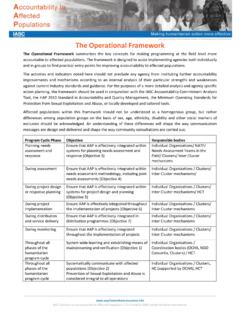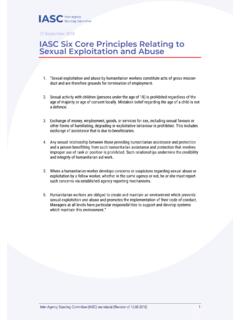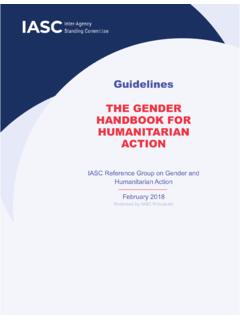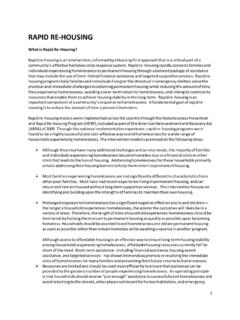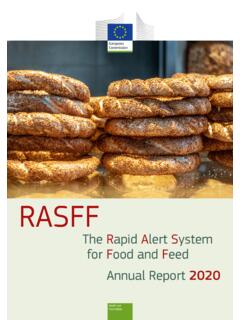Transcription of Guideline EMERGENCY RESPONSE PREPAREDNESS
1 Guideline EMERGENCY RESPONSE PREPAREDNESS July 2015 IASC Task Team on PREPAREDNESS and Resilience Draft for Field Testing EMERGENCY RESPONSE PREPAREDNESS (ERP)JULY 2015 RISK ANALYSIS AND MONITORING MINIMUM PREPAREDNESS ADVANCED PREPAREDNESS AND CONTINGENCY PLANNINGDRAFT FOR FIELD TESTINGThis BETA Version of the Guidance Module was prepared by the Task Team on PREPAREDNESS and Resilience of the Inter-Agency Standing Committee (IASC). The Group is com- posed of representatives from IASC UN agencies, the International Federation of the Red Cross and BETA Version will be revised and finalised in 2016 to take account of feedback from practitioners and further development in guidance and 1: the elementS of eRP7 Management Accountability11 Section 2: RiSK AnAlYSiS AnD monitoRinG 13 Risk Analysis15 Implementing the MPAs26 Advanced PREPAREDNESS Actions (APAs)29 CONTENTSPREFACE5 Who is involved11 The Elements of ERP9 Risk Monitoring17 Section 3: minimUm PREPAREDNESS ActionS (mPAs)21 Section 4: ADVAnceD PREPAREDNESS ActionS (APAs) AnD continGencY PlAnninG27 Contingency Planning29 ANNEXES34 Annex 1.
2 Risk Graph35 Annex 2: Generic Risk monitoring indicators for evolving hazards36 Annex 4: mPA checklist template42 Annex 5: APA checklist46 Annex 6: APA checklist template50 Annex 7: contingency Plan54 Annex 3: mPA checklist38communicating with headquarters19 Implementing APAs and Contingency Planning33 Implementing Risk Analysis and Monitoring204 List of acronyms4 WDatabase: Who does What Where and WhenCAPC onsolidated Appeal ProcessCADRIC apacity for Disaster Reduction Initiative (UN)CERFC entral EMERGENCY RESPONSE Fundchfcommon humanitarian fundclAcluster lead AgencyCODC ommon Operational DatasetCPContingency PlanningEDGE mergency Directors GroupERCE mergency Relief CoordinatorERPE mergency RESPONSE PreparednessEWME arly Warning MonitoringFODF undamental Operational DatasetFTSF inancial Tracking ServiceGclAGlobal cluster lead Agencyhchumanitarian coordinatorhcthumanitarian country teamhiRhumanitarian indicator Registryhnohumanitarian needs overviewhPchumanitarian Programme cyclehRP humanitarian RESPONSE PlanIARRMI nter-Agency rapid RESPONSE MechanismIAESI nter-Agency EMERGENCY SimulationiAheinter-Agency humanitarian evaluationIASCI nter-Agency Standing
3 CommitteeIFRCI nternational Federation of the Red Cross and Red Crescent SocietiesIOMinternational organization for migrationl3level three EMERGENCY responseMPAM inimum PREPAREDNESS ActionsMIRAM ulti-Cluster/Sector Initial rapid AssessmentMTGM onitoring Technical GroupNGOsnon-Governmental organizationsochAoffice for the coordination of humanitarian AffairsOPRO perational Peer ReviewOPSO nline Projects SystemRCResident CoordinatorSOPS tandard Operating ProceduresUNCTU nited Nations Country TeamUNDAC United Nations Disaster Assessment and Coordination TeamUNDAFU nited Nations Development Assistance Framework5 PrefaceThe IASC Task Team on PREPAREDNESS and Resilience has developed the EMERGENCY RESPONSE PREPAREDNESS (ERP) approach to enable the international humanitarian system to apply a proactive approach to EMERGENCY PREPAREDNESS .
4 The ERP guidance builds on the importance placed by the IASC Transformative Agenda on PREPAREDNESS on both the programmatic and financial side and, in particular, for hct and iASc organizations to act on specific early warning indicators to engage in inter agency contingency planning and other coordinated PREPAREDNESS actions to improve collective RESPONSE readiness. The ERP approach can be complementary to development action, through an UNDAF, that seeks to build national and local resilience, including PREPAREDNESS capacity especially where international and national capacity can be closely coordinated. The ERP replaces the Inter-Agency Contingency Planning Guidelines for humanitarian Assistance as developed in 2001 and updated in primary aim of the ERP approach is to optimise the speed and volume of critical assistance delivered immediately after the onset of a humanitarian EMERGENCY .
5 This package provides practical guidance to assist Resident/humanitarian Coordinators1 and humanitarian country teams2 in preparing to respond to potential emergencies with appropriate humanitarian assistance and protection. these guidelines are a tool to: Develop a common understanding of risks and to develop a system to monitor those risks to ensure early action is taken when required. establish a minimum level of multi-hazard PREPAREDNESS . Take additional action, including the development of contingency plans for specific risks that can be used as the basis for initial planning reflected in flash Appeal to meet the differentiated needs of an affected population in the first 3-4 weeks of a humanitarian Rc/hcs as per GA res 46/182 should facilitate the PREPAREDNESS of the United nations system and assist in a speedy transition from relief to development.
6 2 this guidance is written specifically for agencies/organizations involved in providing coordi-nated international assistance and protection to populations affected by emergencies. In most countries there is a standing body, usually a Un country team, led by the Resident/humanitar-ian coordinator, which serves as a forum for these agencies/organizations. for the purpose of these guidelines, this forum is referred to as a humanitarian country team. While participation varies, humanitarian country teams include Un Agencies, international organizations, the International Red Cross and Red Crescent Movement and NGO the majority of emergencies, external support can take days and in some cases weeks to arrive.
7 Therefore, it is vital that there is a plan in place, based on the available in-country capacity, to deal with the initial phase of an ERP focuses on situations in which the scale of the potential EMERGENCY requires the concerted action of a number of guidelines are premised on the understanding that governments hold the primary responsibility for providing humanitarian assistance to women, girls, boys and men and sub-groups of the population in The ERP outlines how the international humanitarian community can organize itself to support and complement national extent of involvement of national and subnational authorities depends on the context. In all situations, EMERGENCY RESPONSE PREPAREDNESS should be based on knowledge of the planning, capacities and systems of national and local authorities.
8 This should be complemented with a knowledge of the underlying inequalities and vulnerabilities influencing risk susceptibility and resilience of women, men and their communities in a given context and guided by the principles of neutrality and eRP design reflects the iASc transformative Agenda s aim to deliver effective relief and protection to affected people by strengthening humanitarian leadership, streamlining coordination, and enhancing accountability. it is part of the humanitarian Programme cycle (hPc). In countries with ongoing emergencies, the ERP approach should be mainstreamed in the humanitarian RESPONSE planning ERP approach serves as a guide for preparing for all emergencies (both slow and sudden onset) requiring a coordinated RESPONSE , during which the Resident/humanitarian coordinator is responsible for ensuring that RESPONSE PREPAREDNESS efforts of relevant organisations are inclusive and coordinated.
9 The international procedures for surveillance, PREPAREDNESS , assessment, and management of public health emergencies of international concerns is set out in the international health Regulations (2005)4 and led by Who. the eRP will guide the PREPAREDNESS for the management of potential humanitarian relief requirements arising with these each State has the responsibility first and foremost to take care of the victims of natural disasters and other emergencies occurring on its territory. hence, the affected State has the primary role in the initiation, organization, coordination, and implementation of humanitarian assistance within its territory. GA Resolution 46/1824 See the definition of public health emergencies of international concerns and the agreed in-ternational procedures under the international health regulations: ; is always an opportunity cost involved in PREPAREDNESS as it puts demands on time and resources.
10 The ERP approach is intended to be flexible and resource- light so that it can be tailored to the capacity of the country ERP enables the humanitarian community to state its capacity and the value it can add to national guide has been designed to be as lean and as user-friendly as possible, in order to be useful to practitioners irrespective of the resources and time available. Throughout this guide, the reader will find Key questions. these are intended to help the country team focus their thinking on the practical matters of greatest importance to successful PREPAREDNESS at each stage of the ERP 1 Three Elements of EMERGENCY RESPONSE PREPAREDNESS (ERP)8 RISK ANALYSIS & MONITORINGMINIMUM PREPAREDNESS ACTIONSADVANCED PREPAREDNESS ACTIONS &CONTINGENCY PLANNINGFLASH APPEALE mergency RESPONSE PREPAREDNESS (ERP) CycleFigure 19 Three Elements of ERPERP is a continuous process, divided into three key elements.



